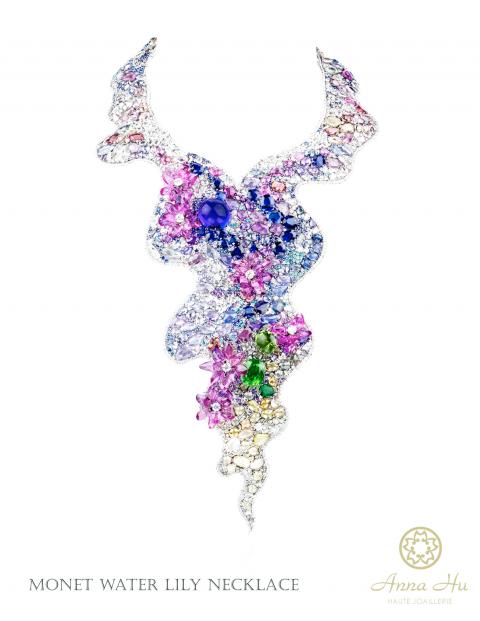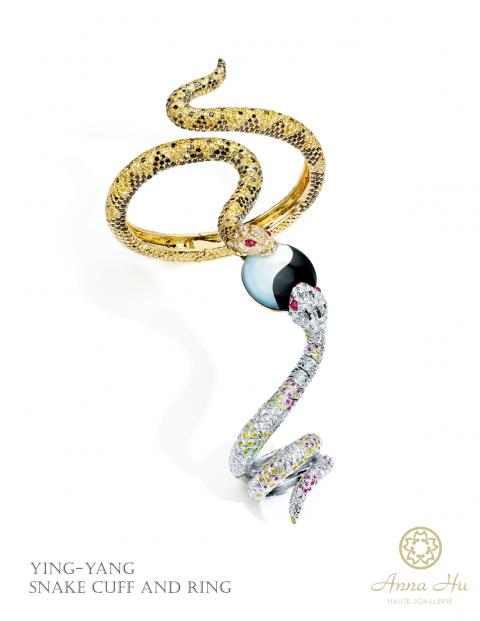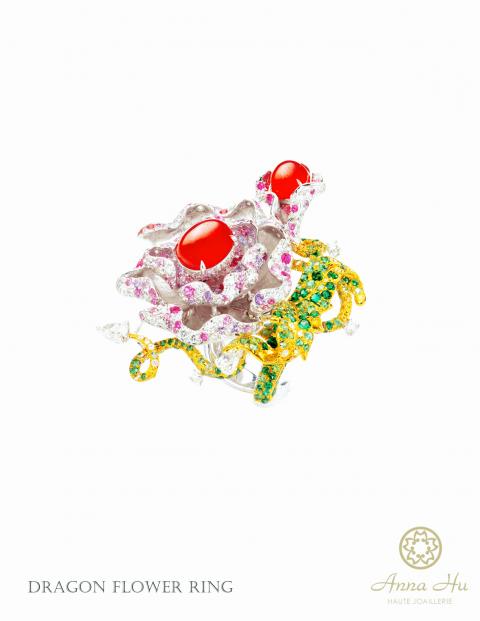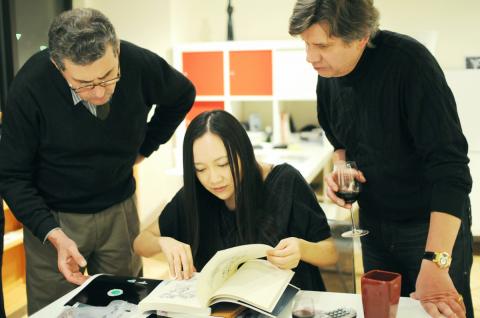Anna Hu (胡茵菲) had her heart set on a career as a cellist until a shoulder injury cut short her musical aspirations. Now the 34-year-old shines as a jeweler whose luxurious, art-inspired designs have attracted clients ranging from Cindy Sherman to Madonna. Her creations also make regular appearances on the red carpet, including February’s Academy Awards, where Scarlett Johansson and Hilary Swank wore pieces that paid homage to Surrealist paintings.
Though she launched New York City-based Anna Hu Haute Joaillerie just four years ago, Hu has already garnered high praise among jewelry connoisseurs and collectors. In a Wall Street Journal profile, David Warren, the director of Christie’s in London and the Middle East, said Hu is considered among the top five or six contemporary jewelry designers in the world.
Born in Taiwan, Hu immigrated to the US with her family when she was a teenager. Though both her parents worked in the jewelry trade, Hu’s first passion was classical music.

Photos courtesy of Anna Hu Haute Joaillerie
“Before I hurt my shoulder, my whole life was about the cello,” says Hu, who practiced at least five hours a day before developing tendinitis. Her chiropractor ordered her to reduce her playing time to half an hour.
With her musical career on hold, Hu felt “very empty.”
“It was in 1997, right around my birthday in March, and for two months it was like hell for me,” she says.

Photo Courtesy of Anna Hu Haute Joaillerie
Then her father, a diamond dealer, suggested that she take a jewelry design class to help lift her out of her depression.
“It was like a transformation for me,” Hu says. “I learned that it doesn’t matter if it’s performing arts or visual arts, it’s all universal.”
Hu, who earned master’s degrees in art history and art administration from the Parsons School of Design and Columbia University, now applies the same perfectionist tendencies to her jewelry that she did to the cello. She cites artists Vincent van Gogh, Gustav Klimt and Chang Dai-chien (張大千) as inspirations; her favorite jeweler is Rene Lalique.

Photo Courtesy of Anna Hu Haute Joaillerie
Despite her celebrity clientele, Hu lays down the law for her custom work and insists on creating pieces that reflect her aesthetic point of view.
“I don’t care if someone is rich or whatever their status is, I don’t give a damn,” Hu says. “They come to me, they listen to me.”
She compares the process of designing a piece of jewelry to composing a symphony.

Photo Courtesy of Anna Hu Haute Joaillerie
“Every gemstone is like a musical note. The contours, the shapes, the lines, are like the melody,” Hu says. “The setting technique, the wax modeling and the construction of the jewelry is really like musical theory, it’s like the rhythm.”
Hu listens to the same pieces of classical music over and over again while working. Johann Sebastian Bach’s concertos are “very symmetrical, very structured, with a lot of symmetry” and inspire her when she creates art deco designs.
Frederic Chopin was her composer of choice while making the bold, lushly detailed jewelry Johansson and Swank wore to the Oscars.
“I related them to Chopin, because they are ultra-romantic and very passionate, with organic curvilinear lines,” Hu says.
Crafted by jewelers in New York City and Paris, Hu’s pieces can take years from conception to the final product. One of Hu’s newest showcase creations, a dramatic collar set with hundreds of precious stones in delicate shades inspired by the artwork of Claude Monet, hails back to a trip Hu made to Giverny, France, when she was 21 years old.
Afterward, she visited the Musee d’Orsay and the Museum of Modern Art in New York City to study Monet’s water lily paintings. While working on the necklace, Hu only listened to works by Impressionist composers Maurice Ravel and Claude Debussy.
The setting of the Monet Water Lily Necklace, which includes various gems in a spectrum of soft, watercolor-like colors offset by glittering diamonds of varying sizes, took more than two years to finish.
Hu began with a sketch before picking different jewels for the piece, treating the precious stones like pigment as she laid them out in a wax model.
When Hu showed the stunningly extravagant final creation to her father, who supplies all her jewels, his jaw dropped.
“We bought all these amazing gemstones and he said, ‘I think you can do about a hundred pieces with them,’” Hu says. “He was expecting a hundred different designs and I put them all into one.”
She has already decided that she will make 999 one-of-a-kind pieces before she retires (the Mandarin pronunciation of nine is a homophone for “longevity”) and organize a solo exhibition of her jewelry every five years. She figures that her plan will keep her busy until she is 75 years old.
“It’s all connected, from music to painting to jewelry. It makes sense to me,” Hu says. “I just feel like I am in another world.”
For more information: www.anna-hu.com

Feb. 17 to Feb. 23 “Japanese city is bombed,” screamed the banner in bold capital letters spanning the front page of the US daily New Castle News on Feb. 24, 1938. This was big news across the globe, as Japan had not been bombarded since Western forces attacked Shimonoseki in 1864. “Numerous Japanese citizens were killed and injured today when eight Chinese planes bombed Taihoku, capital of Formosa, and other nearby cities in the first Chinese air raid anywhere in the Japanese empire,” the subhead clarified. The target was the Matsuyama Airfield (today’s Songshan Airport in Taipei), which

On Jan. 17, Beijing announced that it would allow residents of Shanghai and Fujian Province to visit Taiwan. The two sides are still working out the details. President William Lai (賴清德) has been promoting cross-strait tourism, perhaps to soften the People’s Republic of China’s (PRC) attitudes, perhaps as a sop to international and local opinion leaders. Likely the latter, since many observers understand that the twin drivers of cross-strait tourism — the belief that Chinese tourists will bring money into Taiwan, and the belief that tourism will create better relations — are both false. CHINESE TOURISM PIPE DREAM Back in July

Could Taiwan’s democracy be at risk? There is a lot of apocalyptic commentary right now suggesting that this is the case, but it is always a conspiracy by the other guys — our side is firmly on the side of protecting democracy and always has been, unlike them! The situation is nowhere near that bleak — yet. The concern is that the power struggle between the opposition Chinese Nationalist Party (KMT) and their now effectively pan-blue allies the Taiwan People’s Party (TPP) and the ruling Democratic Progressive Party (DPP) intensifies to the point where democratic functions start to break down. Both

This was not supposed to be an election year. The local media is billing it as the “2025 great recall era” (2025大罷免時代) or the “2025 great recall wave” (2025大罷免潮), with many now just shortening it to “great recall.” As of this writing the number of campaigns that have submitted the requisite one percent of eligible voters signatures in legislative districts is 51 — 35 targeting Chinese Nationalist Party (KMT) caucus lawmakers and 16 targeting Democratic Progressive Party (DPP) lawmakers. The pan-green side has more as they started earlier. Many recall campaigns are billing themselves as “Winter Bluebirds” after the “Bluebird Action”